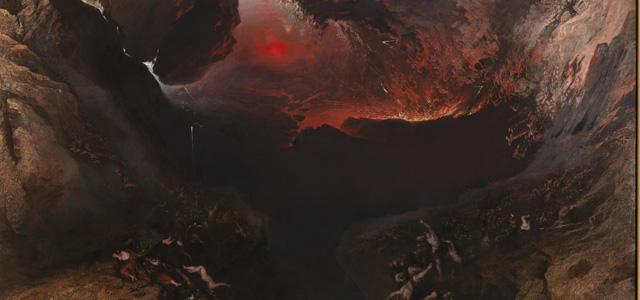Reviews: Picturing the Apocalypse, Natasha and Anthony O’Hear, Oxford.
The Book of Revelation: A Biography, Timothy Beal, Princeton.
After Donald Trump’s election, a bookshop in the US posted a sign saying that post-apocalyptic fiction had now been moved to the ‘current affairs’ section. This joke works because of the wider cultural association of ‘apocalypse’ with the end of the world, but apocalypse is a Greek word meaning simply revelation or unveiling. There is more to the Revelation story than unimaginable, world-ending destruction, although that is naturally the most attention-grabbing aspect of the book.
The language and symbolism John (whoever he may be – theories differ) used in the Book of Revelation has both inspired and confused Christians and non-Christians. Martin Luther famously viewed it as inscrutable, and set it and the letters of James apart from the other books in the contents page of his German New Testament effectively relegating it to an appendix. Although Lucas Cranach’s illustrations made it, ironically, one of the most popular books, and Luther did use it to interpret current events. Countless others have done the same, in order to try and predict the future, though this is not the way it was originally interpreted. Most scholars agree that the symbolism simply referred to Rome, and John had to write in code to veil his criticisms.
In Timothy Beal’s book (part of the Princeton ‘Lives of Great Religious Books’ series), he explains that Saint Augustine, typically, both recognises the symbolism and the dangers of taking it too literally. Beal also says Saint Augustine thinks through in great detail all the implications, such as what resurrected bodies would be like. The medieval Joachim of Fiore thought it was the key to the whole Bible, like the solutions page to a newspaper’s puzzle section, and spent much time working out the chronology.
As a key to reading the signs to predict the imminent future, Revelation has inspired endless interpretation, especially regarding the ‘real’ identity of the Beast, its mark, the whore of Babylon and the like. In the Middle Ages the apocalyptic villain was Islam, or Protestantism or Catholicism, depending which side you were on. In the Cold War, Americans identified the USSR, or international bodies such as the UN or EU, as the Beast. Black South Africans utilised Revelation’s imagery against the apartheid regime. Ronald Reagan, Hilary Clinton and Barack Obama have been targets, and there are already conspiracy theorists crunching the numbers regarding Trump.
The book has been a particular inspiration for artists, but this is tricky, as John’s visions, described in words, often defy painterly representation. Beal takes only a selection of artistic representations, but one of the most interesting is that of James Hampton, an American whose work now sits in the Smithsonian Institution. In his garage, and using household items such as chairs, light bulbs, cardboard tubing and, crucially, miles of silver and gold foil, Hampton created a glittering throne room, annotated with biblical texts and his own indecipherable language. Beal describes it as the greatest work of American folk art.
In Picturing the Apocalypse, a more thorough and academic book, Natasha and Anthony O’Hear describe how in the early Middle Ages artists, often made a series of illustrations, taking Revelation’s scenes one by one, in almost comic book-like fashion. Later artists tended to cram a number of scenes into one picture. A particularly intriguing example is the fifteenth century Apocalyptic Panel of Hans Memling, which is dominated by John himself, then Christ on the throne, in an unusually calm panorama. The four horsemen are almost insignificant details, and not particularly fearsome, in comparison to those of Durer, Cranach and later comic art representations. They look like they are out for a Sunday joyride.
Other artists take one scene to be representative, such as Michelangelo’s Last Judgement, an iconic image standing in for Revelation’s whole. The Romantic painter John Martin painted huge canvasses, like the artists of the Hudson River School, of the sublime outdoors, with humans appearing only as tiny, marginal figures. As well as Noah’s flood, the apocalypse lent itself to Martin’s grand, brooding depictions, with tumbling mountains and fire-filled skies, although the lifelike renderings tend to make the paintings strangely static. In recent decades, artists like Gordon Cheung, whose works have an affinity with Martin’s panoramas, have associated the apocalypse with the ravages of the global financial system and impending environmental collapse. The Manga Bible passes over Revelation surprisingly briskly, though perhaps reinforcing the difficulty of reproducing John’s visions visually. Their fantastical nature sometimes seems better suited to other art forms.
Apocalyptic themes run through classical music, and heavy metal, where the horror movie imagery fits the violent music, but the apocalypse was a surprisingly small influence in African American music. An exception is Blind Willie Johnson’s haunting ‘John the Revelator’. Apocalyptic themes are found in a panoply of films and novels, often in the wider sense of simply the end of the world. The ridiculously lucrative ‘Left Behind’ series of novels and films sticks more or less literally to the script of Revelation itself, appealing to the American evangelical temptation, despite Jesus’ warnings otherwise, to read the signs and calculate the dates. Beal describes, as a young evangelical, being spooked by film evocations of the End Times, which were used by youth ministry teams to scare teens into prayerful vigilance.
Apart from James Hampton and Hans Memling, most of the
artists listed above utilise the power of the war-like and destructive imagery
of Revelation, but the culmination of Revelation is joyous and harmonious. This
is one of the ironies of Revelation, and something often marginalised in
artistic representations of its lurid, unsettling imagery – that it ends well,
and God is in control.
Nick Mattiske blogs on books at coburgreviewofbooks.wordpress.com













